Canyon’s latest Spectral:ON electric mountain bike is intended to tackle the link between bike weight and battery capacity head-on.
An enormous 900Wh capacity battery is matched with a full-power Shimano EP-8 motor, while the frame has 155mm of travel, and is fitted with a host of burly components.
Yet the top-tier Spectral:ON CFR (Canyon Factory Racing) tips the scales at a featherweight 21.87kg (size large, without pedals), defying the commonly held idea that bigger-capacity batteries add considerably more weight to a bike.
Of course, you’re paying for the privilege of a lower weight with the Spectral:ON CFR, which costs £8,599 / $10,150 / €8,999.
That price is well matched with the CFR’s spec, however. It’s fitted with a full Shimano XTR M9100 drivetrain and brakes, Fox’s Factory-level suspension and dropper post, and Reynolds carbon fibre mullet (29in front, 27.5in rear) wheels.
Canyon Spectral:ON CFR frame, suspension and motor
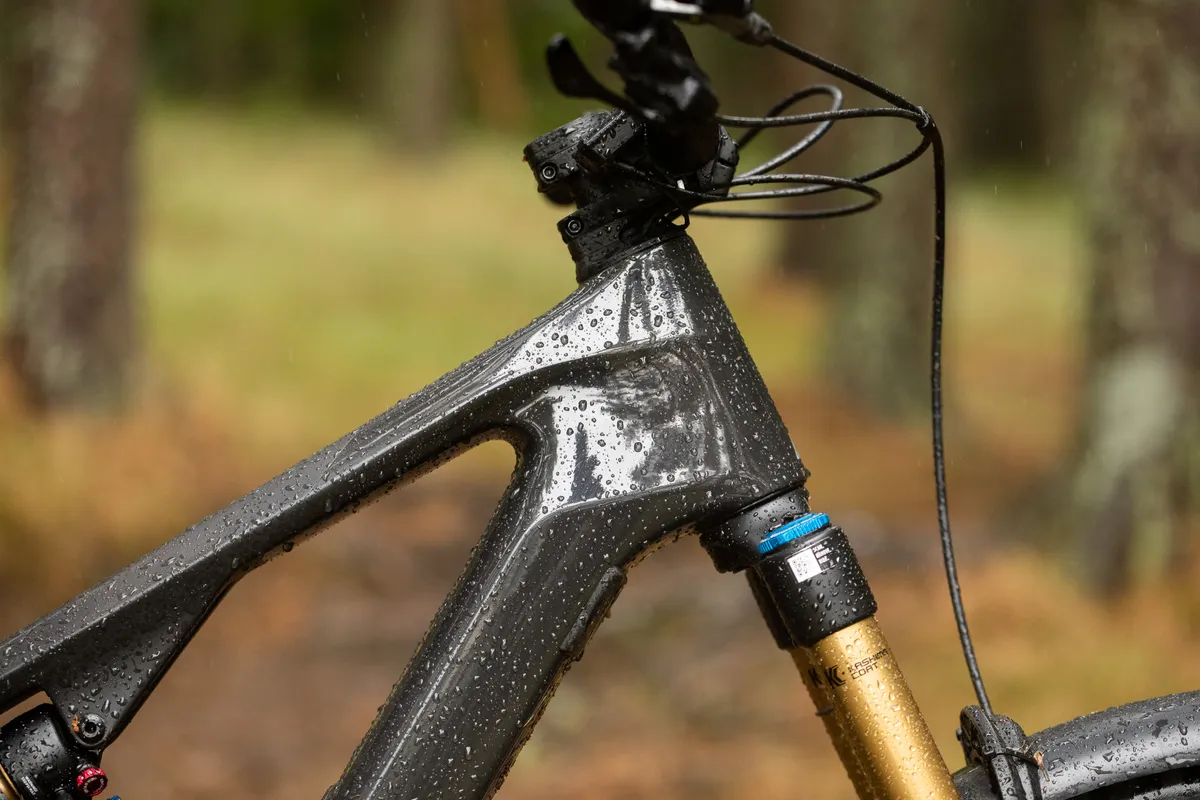
The Spectral:ON CFR’s frame is made from carbon fibre the brand claims has the same layup as components used for space travel. Canyon says this makes for light, tough and high-performing frames where strength is a priority.
The CFR has been awarded a Category 4E safety standard, which is the second highest level. Its strength is matched by the frame’s claimed stiffness, created by the chunky carbon fibre swingarm with 15mm pivot axles and large bearings, and a bridge between the seatstays.

There's plenty of integrated chain-slap protection, while the underside of the motor is encased in a protective ‘sump guard’ that can be removed without tools to access the battery. The bottom portion of the down tube also has rock-strike protection.
The main pivot has a cover to reduce the chances of rocks getting caught between the swingarm and main frame as the suspension cycles.

Its cables are routed internally via the headset, a system seen on other bikes such as Nukeproof’s Megawatt and the Vitus E-Sommet. The rear dropout uses SRAM’s Universal Derailleur Hanger (UDH), and axle spacing is Boost 12x148mm.
A carbon fibre bottle cage is supplied, and thanks to the frame’s layout, there’s ample space or a 750ml bottle.
Canyon Spectral:ON CFR suspension kinematics
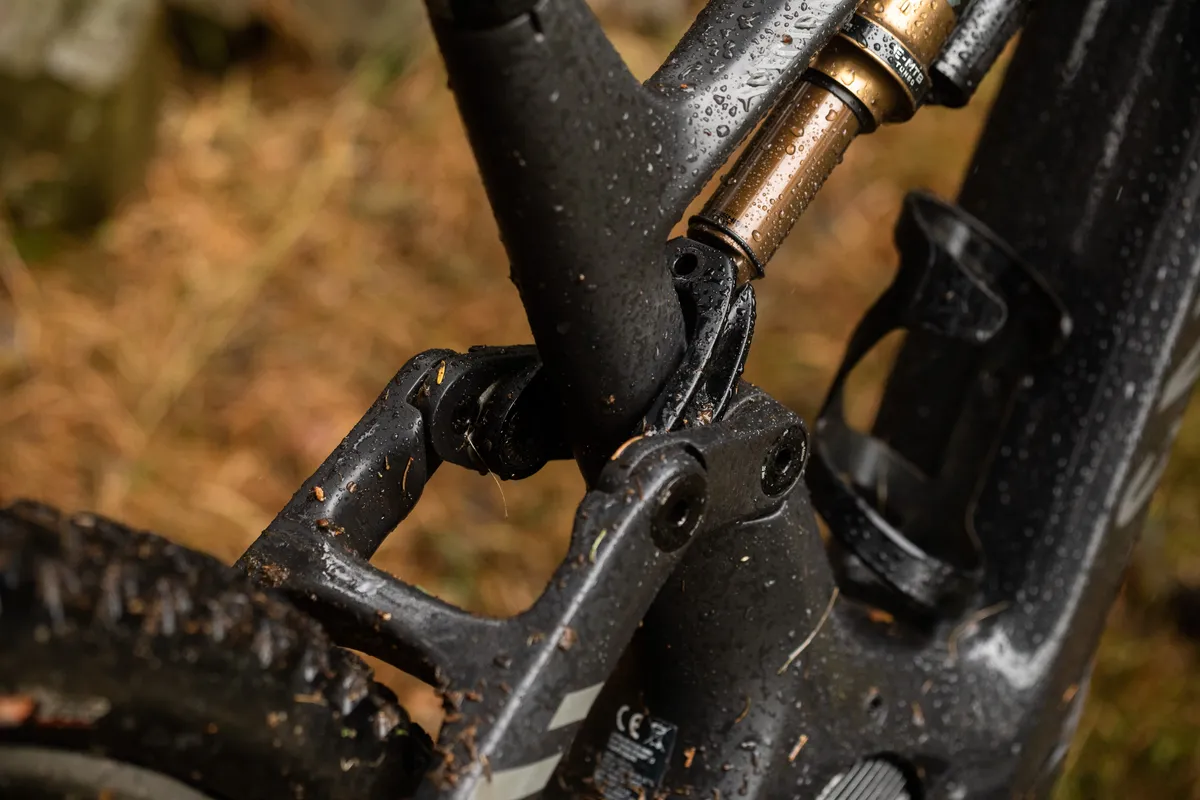
Like the rest of Canyon’s full-suspension bikes (except the Lux), the Spectral:ON CFR has a Horst-link suspension design, where the rear wheel is attached to the seatstay behind the pivot that joins the seat and chainstays together.
According to Linkage Design, the 155mm of travel has a 21.31 per cent rate of progression. The leverage rate is relatively linear until the last 50mm of its travel, where it flattens out in a bid to compensate for the quick progression ramp-up of air springs.
At sag, it has 80 per cent anti-squat, where pedalling forces are more likely to cause the suspension to bob than not.
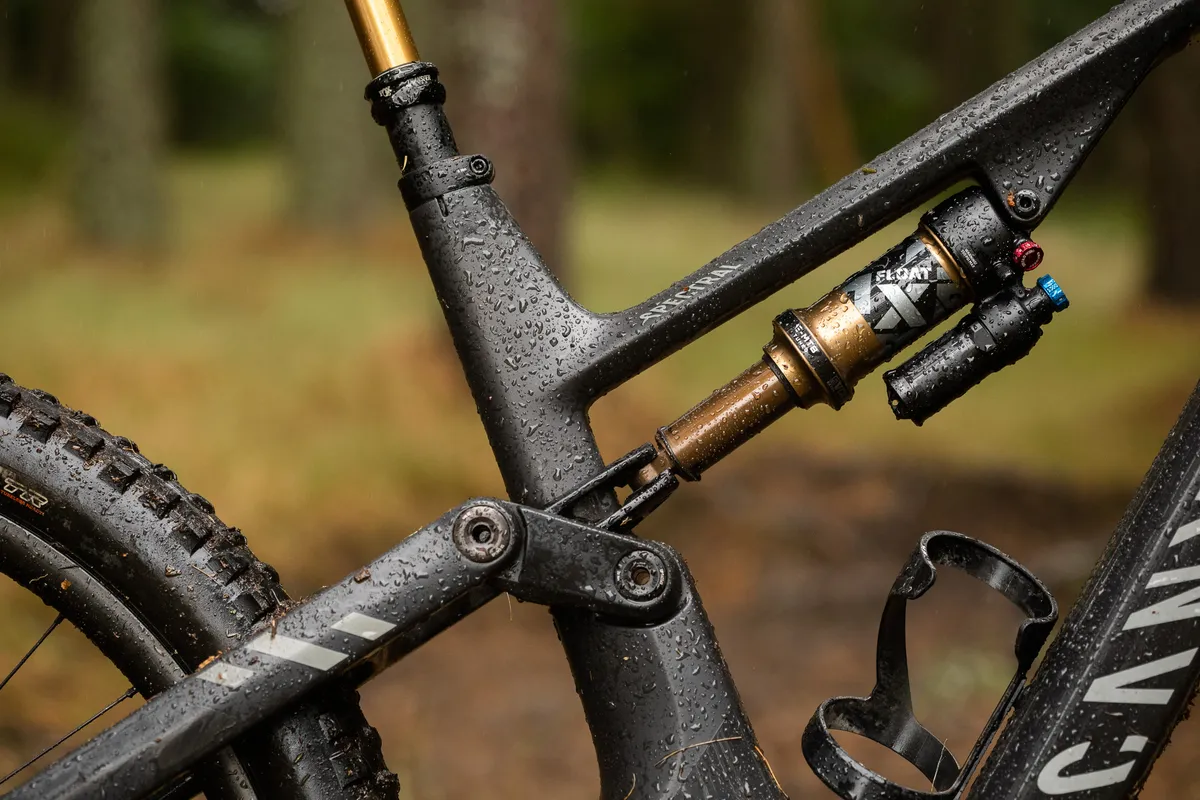
The clevis-style shock mount means the Spectral:ON CFR isn’t compatible with coil-sprung shocks, where “the forces transferred [in such a design] to the smaller-diameter damper shafts used in coil shocks is quite high and can lead to shock failures”, according to Canyon.
Canyon Spectral:ON CFR battery and motor

Shimano’s 85Nm torque and 250w EP-8 motor is paired with Canyon’s own 900Wh battery stored within the down tube and secured in place with two 6mm Allen head bolts.
The battery is removed and fitted by sliding it in and out of the bottom of the down tube. It has a single magnetic Rosenberger RoPD connector that doubles up as the charging port and motor power hook-up. The battery can be charged on or off the bike.

Canyon says the battery’s cells are positioned horizontally (rather than vertically) which means more cells can be fitted in the same space, and without increasing weight significantly.
On my scales the 900Wh Canyon battery weighed 3840g, only 320g heavier than Shimano’s own BT-E8036 630Wh unit (3520g).
If that’s not light enough, the Spectral:ON CFR can also be supplied with a 720Wh battery, reducing weight further.
Canyon Spectral:ON CFR geometry

Amongst other changes, this iteration of the Spectral:ON underwent some geometry transformations getting the longer, lower and slacker treatment.
The Spectral:ON is a trail bike rather than an enduro bike, and its figures reflect that. Canyon is the first to admit it’s “not the longest, slackest bike in the world”. This, the brand hopes, means the CFR can be ridden over the widest variety of terrain types.
| | Small | Medium | Large | Extra-Large |
|---|---|---|---|---|
| Rider height (cm) | 166-175 | 175-183 | 183-192 | 192-200 |
| Top tube length (mm) | 589 | 613 | 637 | 663 |
| Head tube length (mm) | 115 | 125 | 135 | 145 |
| Head tube angle (degrees) | 65.50 | 65.50 | 65.50 | 65.50 |
| Seat tube length (mm) | 420 | 440 | 460 | 480 |
| Seat tube angle (degrees) | 76.50 | 76.50 | 76.50 | 76.50 |
| Chainstay length (mm) | 440 | 440 | 440 | 440 |
| Wheelbase (mm) | 1,194 | 1,223 | 1,252 | 1,281 |
| Stack (mm) | 634 | 643 | 652 | 661 |
| Reach (mm) | 435 | 460 | 485 | 510 |
| Standover height (mm) | 809 | 814 | 820 | 825 |
| BB drop front/rear (mm) | 35.5/19 | 35.5/19 | 35.5/19 | 35.5/19 |
| Front travel (mm) | 150 | 150 | 150 | 150 |
| Rear travel (mm) | 155 | 155 | 155 | 155 |
Up-front is a 65.5-degree head tube angle, matched with a 76.5-degree seat tube angle.
The range’s four sizes (small to extra-large) all have 440mm chainstays, while the wheelbase on the size large I tested is 1,252mm. The size large’s stack is a lofty 652mm and the bottom bracket sits at 334mm above the ground.
Reach figures span from 435mm (small) to 510mm (extra-large), with the large getting a 485mm reach, combined with a 637mm top tube.
Canyon Spectral:ON CFR specifications

Despite the asking price of the Spectral:ON CFR looking pretty expensive, its spec goes a long way to justify the cost.
Up-front is Fox’s 36 Factory fork with 150mm of travel, matched to Fox’s Float X Factory air-sprung rear shock. Also from the Fox stable is a Transfer Factory dropper post, with 175mm of travel for the size large.

Drivetrain and stopping duties are taken care of by Shimano’s range-topping XTR M9100 components, where the four-piston M9120 brakes are matched with 203mm Ice Tech rotors front and rear.
Reynolds deep dish TR 309 E (front) and TR 367 E (rear) rims are laced to Reynolds Tre hubs with Sapim E-Lite spokes. These are wrapped in Maxxis rubber, with an Assegai 29x2.5in Maxxis 3C MaxxTerra EXO on the front and a Minion DHRII 27.5x2.6in 3C MaxxTerra EXO+ at the rear.

The grips, bar and stem are Canyon-branded, while there’s a Fizik Terra Aidon X5 saddle.
The size large test bike, without pedals, weighed 21.87kg on my scales.
Canyon Spectral:ON CFR ride impressions

I tested the Canyon Spectral:ON CFR on my home trails in Scotland’s Tweed Valley over several months.
Given Canyon’s claims the Spectral:ON is designed as a total generalist, I rode the widest range of trails possible to see how the bike performed. These ranged from the famous Glentress and Innerleithen trail centre loops (the former of which is due to host the 2023 cross-country MTB World Championships), rugged backcountry bridleways and purpose-built enduro runs, sometimes all in one ride.
This helped me gather a rounded idea of where the bike did and did not perform well.
Canyon Spectral:ON CFR setup

Setting up the Spectral:ON CFR was straightforward; its dampers are a known quantity to me and I have preferred settings.
In the Fox 36 fork, I installed one volume-reducer spacer to the pre-installed two, taking the total count to three. I inflated the air spring to 94psi, which gave a generous 39mm sag. I turned all the external compression and rebound damping adjusters to fully open and left them like this for the entire test period.
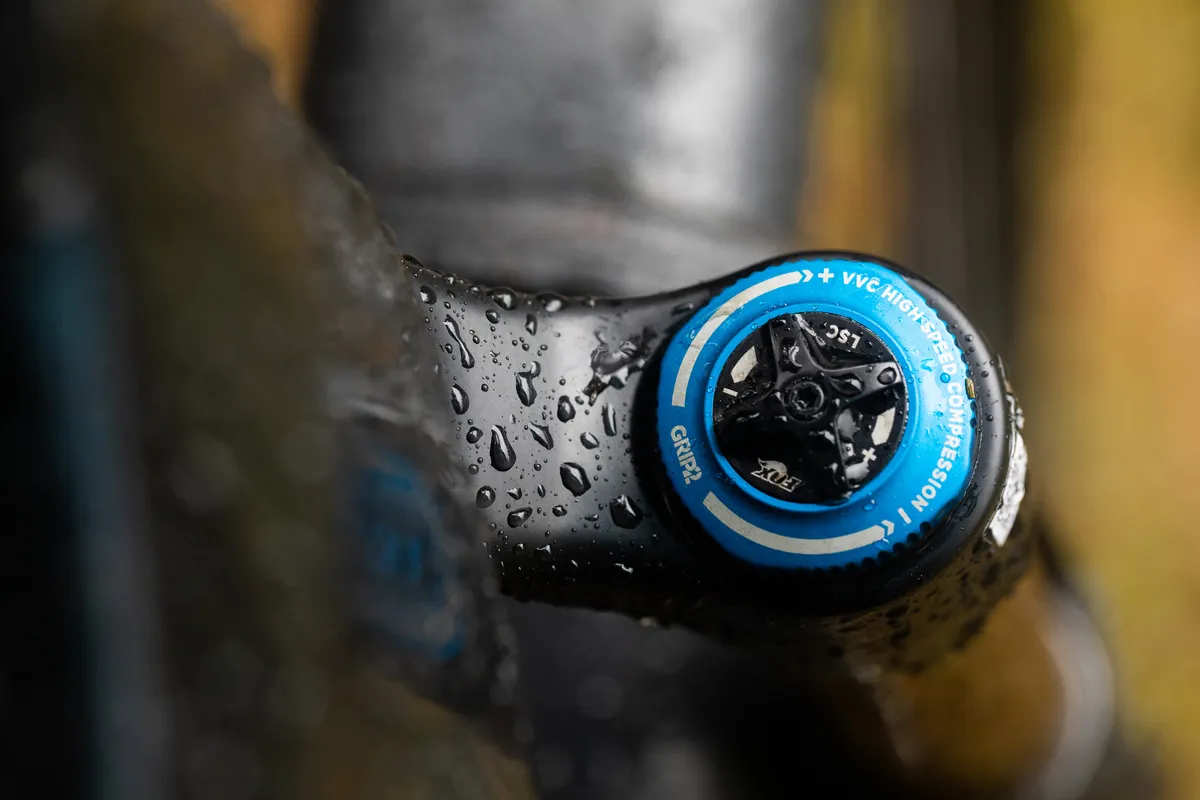
After initially setting the shock to 170psi (18mm/30 per cent sag), I experimented with slightly lower pressures (down to 162psi) to improve comfort, but found this lowered the bottom bracket too far, causing pedal strikes. I settled on the initial 170psi and left the external compression and rebound adjustments fully open.
Canyon Spectral:ON CFR climbing performance
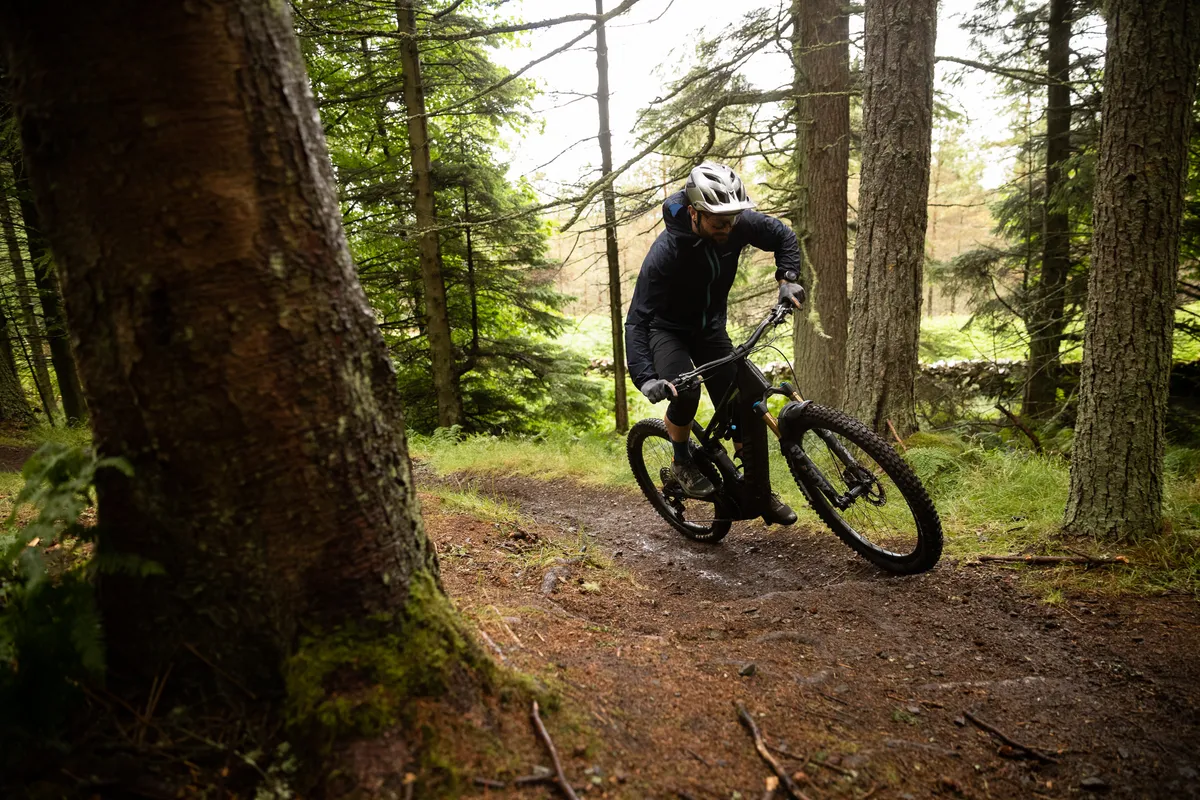
The impressively low-weight, fast-rolling tyres and high-capacity 900Wh battery meant the Spectral:ON was remarkably quick when pointing uphill.
This sprightliness made it possible to cover long distances rapidly with relatively little effort, even with the motor set to its lower assistance modes.
I wouldn’t go as far as saying the Spectral:ON rode like a regular mountain bike with the assistance turned off, but once the mammoth battery did finally run out, there wasn’t a correspondingly onerous heft to lug home under your own steam, at least compared to other full-fat, slower-rolling electric bikes.

Suspension smoothness was good, where the rear shock and fork both fluttered in and out of their travel with a level of plushness. While ascending, this offered a traction-rich ride, where the dampers worked hard to keep the wheels in contact the with the ground. At lower pressures, the chunky 2.6in wide rear tyre enhanced grip further.
The active rear end’s beginning stroke was complemented by supportive undertones, where deeper into the Spectral:ON’s travel there was plenty to push against. On steeper climbs, this helped maintain the bike’s geometry thanks to the suspension resisting further sagging when my weight was concentrated over the rear wheel.
This also helped with maintaining speed on undulating terrain, where pumping was a useful tool for building speed, and rider movements weren’t sapped by soggy suspension.
A trail-focused ride

On undulating trails with shallow gradients, the seated riding position felt comfortable, where not too much of my weight was put through either my sit bones or hands.
I did, however, push the seat fully forwards in its rails and angle its nose down to help compensate for the seat tube angle.
While the angle wasn’t terribly slack, swapping between the Spectral:ON and bikes with steeper seat tube angles did highlight it could be improved to aid control and reduce front-wheel lift. I found myself sitting on the nose of the saddle on shallow inclines, a technique usually reserved for very steep gradients.
It isn’t a deal breaker, however, and the seat angle was well-suited to the go-anywhere credentials of the Spectral:ON.
Questions on comfort

As I mentioned in the setup section, I experimented with lower shock pressures to improve comfort.
While the suspension remained impressively supple regardless of it being set up slightly firmer or softer, the Spectral:ON CFR’s overall ride feel remained quite raw, especially on worn-out fire roads or trail centre surfaces with high-frequency, low-profile bumps.
This rawness was felt mostly through my hands and left me yearning for a comfier ride to help reduce fatigue and extend saddle time.

Although I couldn’t accurately pinpoint where the harshness came from, clearly the chunky carbon fibre frame (both front and rear triangles), deep carbon fibre wheels and EXO-casing, high-volume rubber were all contributors.
While reducing suspension and tyre pressures did help take the edge off it, both had negative effects elsewhere.
Decreasing spring pressure meant the bottom bracket was low enough to up the frequency of pedal strikes too much, making carrying speed over rougher, chunkier terrain tricky.

Lowering tyre pressures increased grip and improved comfort, but the EXO front and EXO+ rear tyre casings struggled to keep their shape and not burp air when pushed hard in turns. The chance of punctures was increased massively.
Given the Spectral:ON’s trail-riding focus and all-day battery power, comfort should be a priority. Adjusting the bike to improve this resulted in compromises elsewhere that shouldn’t need to be made.
Canyon Spectral:ON CFR battery life

One of the Spectral:ON CFR’s biggest draws is its massive 900Wh battery, weighing just 3,840g.
Out on the trail, this extra capacity results in a reasonable, but not incredible, increase in range.
Compared to Shimano’s 630Wh BT-E8036 (Shimano’s biggest battery), I found the Canyon’s 900Wh unit with the EP-8 motor set to Boost delivered around 60m to 100m of additional ascending per 20 per cent of charge.
In mixed-mode usage (roughly 20 per cent in Boost, 40 per cent in Trail and 40 per cent in Eco), it was possible to exceed 2,000m of ascending from a single charge, something the 630Wh battery could only do when set exclusively in the Eco mode.

In Eco only, it was possible to knock on the door of 2,500m to 2,700m of ascending from a single charge on the Spectral:ON.
Weather and trail conditions and trail type, along with system weight, all influence battery life, so different riders might not experience the same range as I did.
Canyon Spectral:ON CFR descending performance

On freshly built, smoother and flatter descents with low-to-medium speeds, the Spectral:ON CFR felt brilliant.
The supportive suspension and light weight gave it a poppy and playful character, where hopping from one side of the trail to the other to switch lines was both rewarding and fun.
This was amplified by the taught feel, where steering accuracy was virtually faultless, making line choice accurate and precise.
It was the same story on flow or jump trails, where the supportive rear end made using energy to boost take-offs rewarding, and the ramp up meant there was plenty of support and cushioning when landing, even if that was to flat.
Geometry generalist

Hitting banked turns was confidence-filled, where the high 652mm stack made weighting the front wheel intuitive, and reduced the feeling of tipping over the front some bikes with lower front ends can give.
Add the low bottom bracket to the mix, reducing the rider and bike’s centre of gravity, and changing direction was a quick and easy affair.
Hard cornering was augmented by the supportive suspension, where it was possible to push through the bars and pedals to load the bike up to grip without excessive, destabilising geometry changes. This made the Spectral easy to ride in the turns.
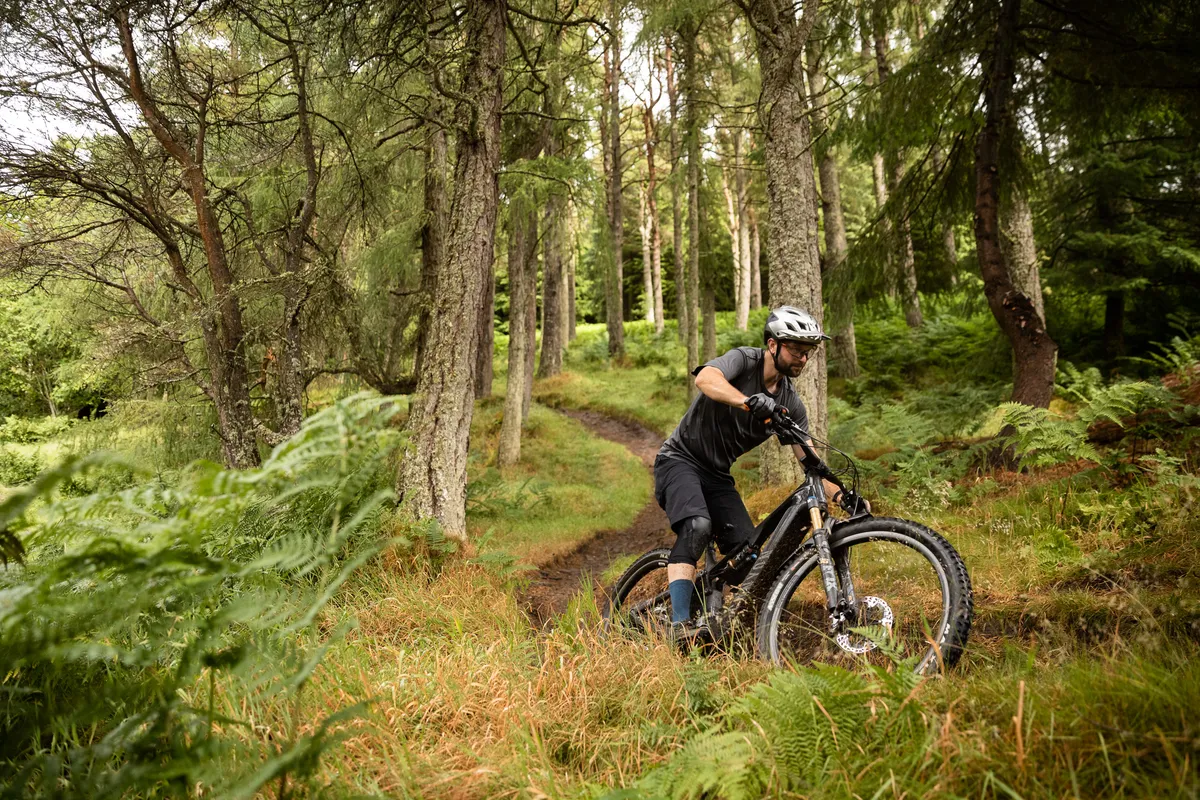
Its geometry was well suited to red-graded or easier trail centre runs, or less technical natural singletracks. On the smoother trails, it was happy at higher speeds, too, where stability wasn’t too much of an issue.
However, if the trails got chunkier, rougher and faster, the Spectral’s geometry had clear limitations.
On steep sections with sharp turns, the front wheel wanted to tuck thanks to the head tube angle, while on rough terrain the wheelbase and chainstay figures meant stability was reduced, with pitching motions being more pronounced compared to longer bikes.
Speed-focused rubber

The MaxxTerra tyres upped speed, offering less rolling resistance than the tackier MaxxGrip versions. The pay-off for those higher rolling speeds was a lack of sure-footedness on greasy and damp trails, reducing control where it was needed most.
Wet roots and rocks frequently caught me off-guard despite anticipating and adjusting my riding, where the tyres would slide rather than roll over them. Although the MaxxTerra compound alone isn’t terrible, match it with stiff wheels and the lack of forgiveness is certainly amplified.

The high-volume rear tyre struggled to bite into hardpack or greasy ground when on the brakes. Instead, it skimmed over the trail’s surface.
Lower pressures helped, but this resulted in questionable tyre-carcass stability.
Raw ride
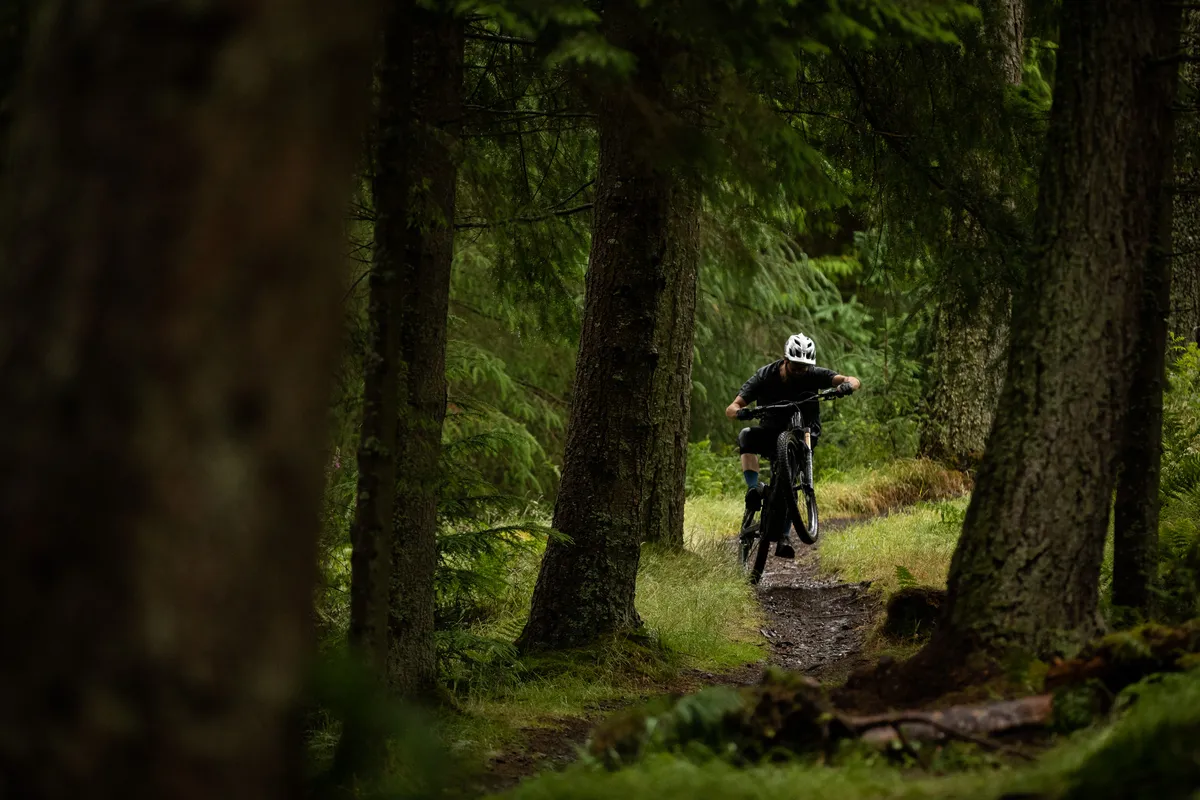
The same raw ride felt on the climbs and flatter sections is eminently present on the descents, especially when bump frequency increases.
There’s a lack of forgiveness and insulation from the trail’s surface. While that means you can feel everything the bike is doing and each bump it rides over with pinpoint accuracy, it makes the ride quite fatiguing.
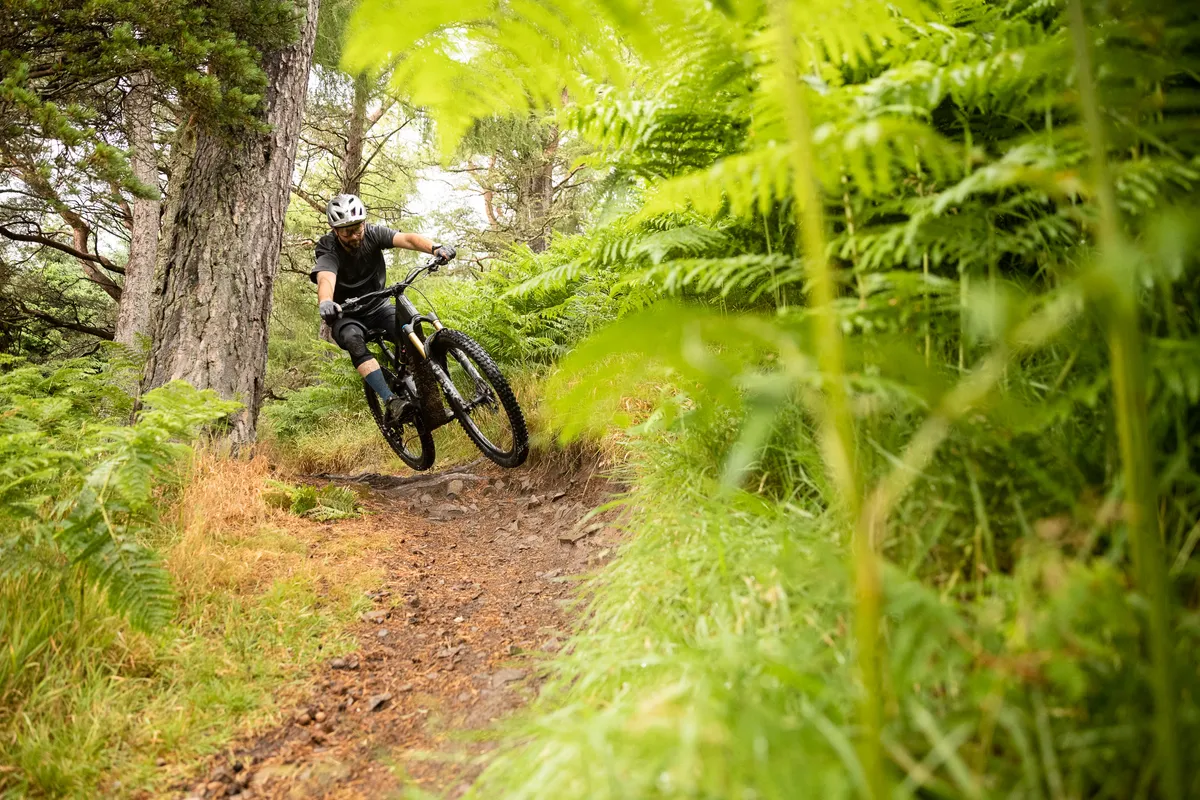
Fatigue isn’t the only issue, where the bike’s stiffness, when combined with the less sticky compound tyres, negatively impacts traction. The Spectral feels more skittish than planted on rougher trails, regardless of weather conditions.
Reduce your speed, and comfort and traction are much improved, however.
Sound amplifier

The wide, flat down tube not only stores the high-capacity battery, but also does a great job of amplifying any rattle, clunk or noise the bike makes.
This was unfortunate for the Spectral’s EP-8. Renowned for its noisy freewheel, it sounded and felt even worse compared to other bikes because the Canyon’s tubes augmented how noisy it was. Those vibrations made their way into my hands and feet.
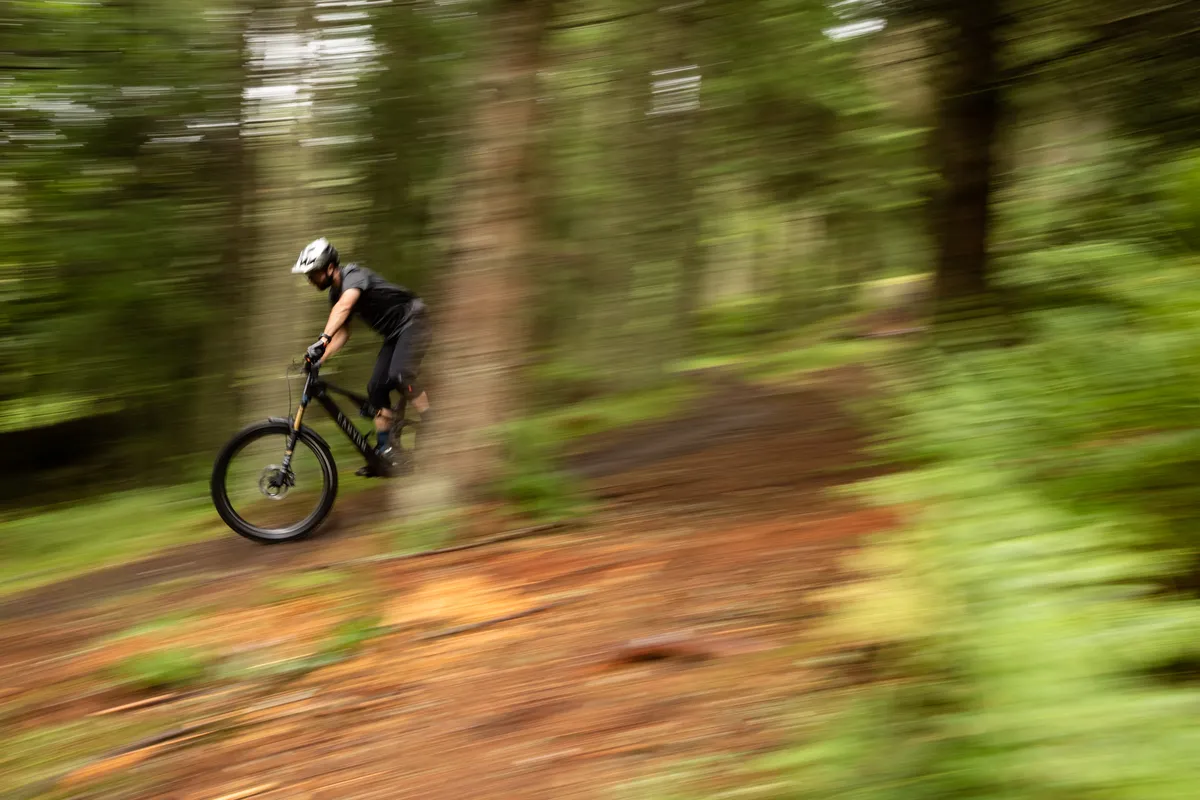
Coupled with an untraceable creaking sound emanating from the battery/motor/down tube/seat tube junction – that sounded like a poorly tightened headset – the Spectral sounds more like a drummer than a mime artist on the trails.

Tip the bike over and put pressure through the non-driveside pedal crank and it was possible to observe a small amount of movement between the frame, motor and battery, which was potentially the cause of the creaking noise when riding.
This didn’t appear to affect performance, but was frustrating and tainted the otherwise-premium feel.
This wasn’t a one-off problem with my test bike – I bumped into several other Spectral:ON CFR riders whose bikes made the same noise.
How does the Canyon Spectral:ON CFR compare to the Specialized Turbo Levo?
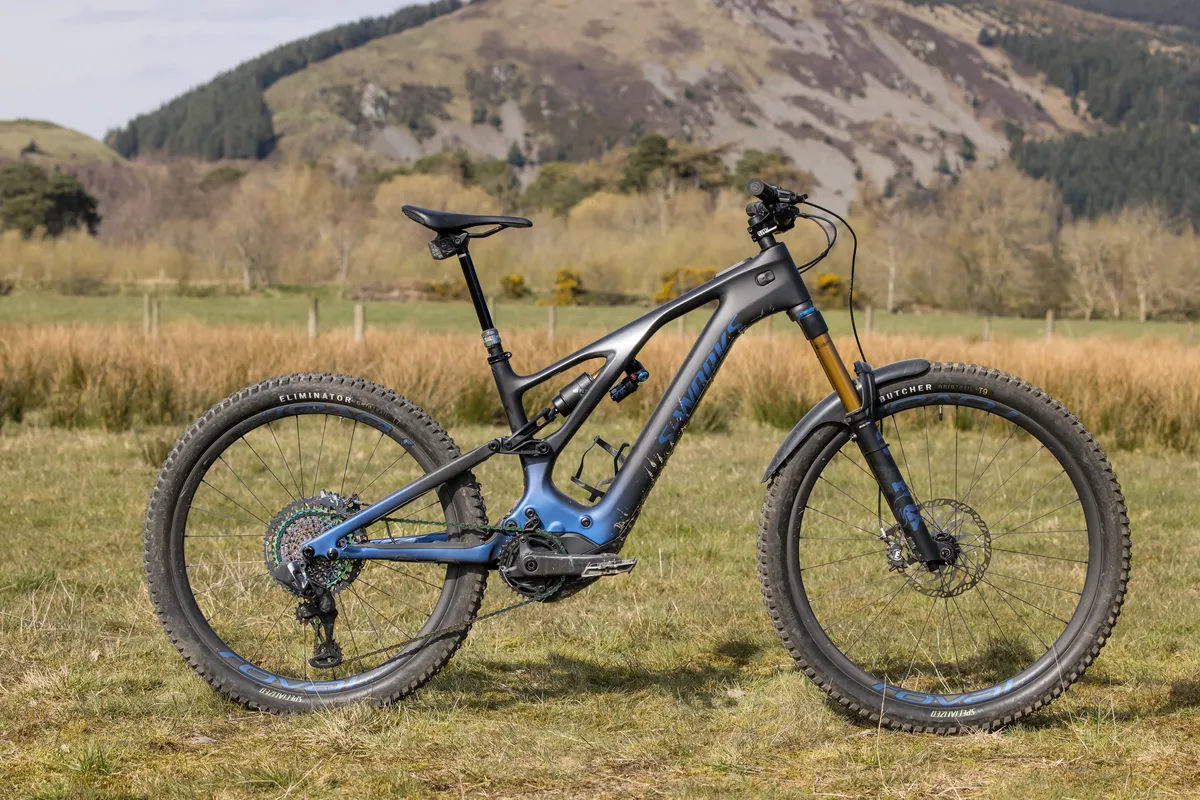
The Spectral’s most obvious competitor is Specialized’s Turbo Levo, also positioned as a trail bike.
In terms of battery capacity and overall weight, the Canyon’s is a fair chunk bigger than the Specialized’s 700Wh unit, and overall weight is 500g lighter. That gives the Spectral the edge in my eyes, but some may prefer the quieter operation and feel of Specialized’s Brose motor.
It’s hard to overlook the cost, too. When I tested the S-Works Turbo Levo, it retailed for £13,000 / $15,000, but that has since increased to £14,250 / $15,000, which is a massive amount more than the Spectral:ON CFR’s £8,599 / $10,150 price.

Things become less clear in terms of components. The Spectral’s Fox 36 feels under-gunned compared to the Turbo Levo’s 38, and while the Canyon’s Float X is a good shock, the additional adjustments of the Float X2 on the Specialized are welcome.
Shimano’s XTR M9100 is a true performer, but the XX1 Eagle AXS kit on the Turbo Levo was also faultless. Personal preference will be a deciding factor here.
However, the Turbo Levo truly outdoes the Spectral in terms of its geometry. The multitude of adjustments can morph the Specialized from long, low and slack enduro bike to knocking on the door of lightweight trail geometry.

This isn’t something the Canyon boasts, remaining steadfast in its tracks by not offering a single adjustment to its middle-of-the-road figures.
Had Canyon offered a level of adjustability from the stock geometry starting point, there’s no denying the Spectral would be quickly closing in on the Turbo Levo’s seemingly unbeatable formula.
In this sense, it feels Canyon has missed a clear opportunity to challenge the supremacy of the Turbo Levo.
Canyon Spectral:ON CFR performance details
- Frame protection: Fitted to the outer faces of the chainstays and seatstays is clear 3M tape, designed to protect the carbon fibre construction from foot rub.Granted, although I’m particularly bad at rubbing through paint in these areas, the 3M tape lasted one ride before it started to peel and detach from the frame, looking scruffy.To help reduce the chances of this, Canyon could wrap the stays with the tape rather than leaving the tape’s edges exposed, accelerating peeling.There’s ample chain-slap protection on the chainstay, but the chainring’s size and thee stay’s design means the chain runs over the protection when higher gears are selected.Although Canyon says this is intentional and helps to reduce the amount of chain slap, I question the longevity of the protection when it’s in frequent contact with the chain.

- XTR M9100 groupset: I was vastly impressed by the groupset’s performance. Shifting was reliable and smooth, and the derailleur seemed robust enough to handle the extra stresses and strains generated by the motor’s assistance. There were also plenty of gears, extending its climbing potential. Descending, the derailleur did a great job of stopping chain slap (and its clutch can be tensioned further if it becomes an issue). The immensely powerful M9120 four-piston brakes and Ice Tech pads are fade-free, even on the longest, steepest and most gruelling descents.

- Maxxis MaxxTerra compound, EXO and EXO+ casing tyres: Extending battery life is all about reducing weight and rolling resistance, two things the tyres specced on the Spectral:ON CFR do well.However, these are a compromise too far. They lack predictable traction in the wet, and the EXO and EXO+ casings are too thin for ebikes, where lower pressures caused carcass instability and increased the chances of punctures.I’d gladly add a kilogram of weight to the bike’s overall figure to access grippier, more damped and better-performing tyres.

- Connection troubles: Although the single Rosenberger RoPD magnetic connector is sleek and reduces the number of internal cables from the motor, battery and charging port, the plastic housing interfered with the connection’s reliability. Several times while riding, the connection failed, causing the bike to turn off. Removing the connector’s plastic cover resolved the issue, but the jigsaw-like design of the covers and sump guard meant getting all the parts to sit correctly, and the battery and motor to remain connected was trickier than it should be.

Canyon Spectral:ON CFR bottom line

There’s no denying the Spectral:ON CFR is a great lightweight electric trail bike, well suited to smoother, flatter, less demanding trails. Its poppy suspension, fast-rolling tyres and precision-focused chassis all lend themselves to having a blast and are backed up by an impressively long-lasting battery.
However, Canyon has missed an opportunity to topple the great Turbo Levo. If it had managed to blend the incredible battery capacity, weight figure and price of the Spectral with the Turbo Levo’s geometry and ride quality, finding criticisms would be tricky.
If your definition of trail riding falls within the Spectral:ON’s confines, there’s no denying it’s a great bike, but the lack of adjustability and conservative angles certainly limit its outright potential and its ability to fit in with the arguably flexible definition of trail riding.
Product
| Brand | canyon |
| Price | 8999.00 EUR,8599.00 GBP,10150.00 USD |
| br_whatWeTested | Canyon Spectral:ON CFR |
| Weight | 21.8700, GRAM (Large) - Size large, without pedals |
Features
| Fork | Fox Float 36 Factory |
| br_stem | Canyon:ON ST0031 |
| br_chain | Shimano XTR M9100 |
| br_frame | Canyon Spectral:ON CFR |
| br_motor | Shimano EP-8 |
| Tyres | Maxxis Assegai 3C MaxxTerra EXO TR 29x2.5in (f), Maxxis Minion DHR II 3C MaxxTerra EXO+ 27.5x2.6in (r) |
| br_brakes | Shimano XTR M9120 |
| br_cranks | Shimano |
| br_saddle | Fizik Terra Aidon X5 |
| br_wheels | Reynolds TR 309 E on Tre hub (f), Reynolds TR 367 E on Tre hub (r) |
| br_headset | Canyon |
| br_shifter | Shimano XTR M9100 |
| br_cassette | Shimano XTR M9100 10-51t |
| br_seatpost | Fox Transfer Factory |
| br_gripsTape | Canyon Lock-on |
| br_handlebar | Canyon:ON HB0057 |
| br_rearShock | Fox Float X Factory EVOL |
| br_bottomBracket | Shimano EP-8 |
| br_availableSizes | Small, medium, large, extra-large |
| br_rearDerailleur | Shimano XTR M9100 |

